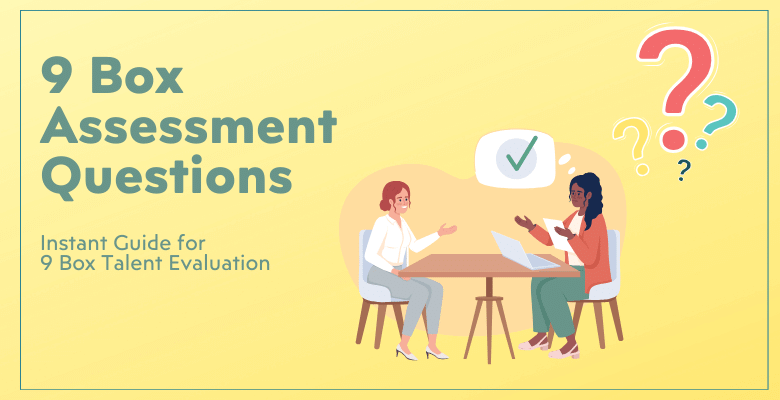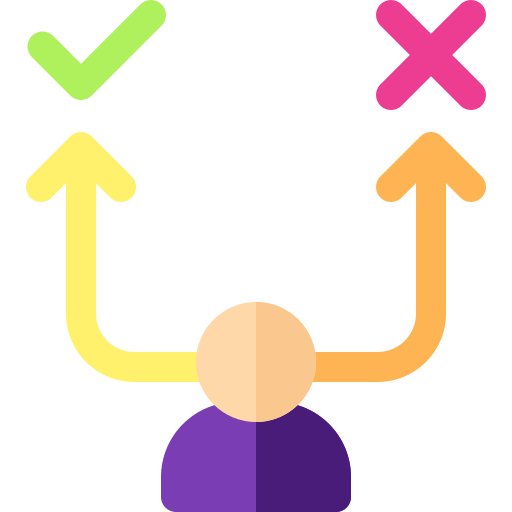
9 Box Assessment Questions: A Quick Guide for Managers
In this article we’ll work on the most common questions for 9 box evaluations. Before starting your evaluation process, let’s checkout 9 Box Assessment Questions.
Table Of Content
1. Understanding 9 Box Assessment
2. Qualities To Assess
3. Key Questions for Employee Evaluation
4. Interpreting Assessment Results
5. Improving the 9 Box Assessment Process
6. A 9 Box Assessment Case Study
7. FAQ’s
1. Understanding 9 Box Assessment
This part will talk about the basics of the 9 Box Assessment, what it’s used for, and how it fits into talent management and evaluating employees.
Companies use the 9-Box Assessment to find out how well their workers are doing and what they could do better. This chart shows workers where they stand in terms of what they’ve done for the company and how much room they have to grow and move up.

Purpose of the 9 Box Assessment
The 9 Box Assessment’s main goal is to help with managing people and planning for the next generation of leaders. It gives HR professionals, managers, and executives a clear picture of their employees, which helps them find high-potential workers, fill in skill gaps, and make smart choices about leadership growth.
How the 9 Box Assessment Works?
Most of the time, workers are judged on two main factors: their performance and their potential. A grid with nine boxes or pieces is often used to show these measurements. Then, employees are put in one of these boxes based on their performance (how well they do their job right now) and their potential (how well they could do in the future, take on more responsibility, and move up in the company).
 10. What Are 9 Box Alternatives?
10. What Are 9 Box Alternatives?
Significance of the 9 Box Assessment
The 9 Box Assessment helps groups in a number of ways:
- Talent Identification: This helps find employees who are doing a great job and have a lot of promise. This makes it easier to train and develop future leaders.
- Succession Planning: Grouping employees into categories helps companies prepare for leadership changes and make sure that tasks are handed off smoothly.
- Allocation of Resources: It helps to make good use of resources, making sure that development efforts are focused on workers who can make the company successful.
- Skill Gap Analysis: This test finds skill gaps in the workforce, which helps companies decide which training and development programs to focus on.
We’ll talk more about the specific qualities that the 9 Box Assessment looks at and the main questions that are used to judge workers in the next sections.
2. Qualities To Assess
In this part, we’ll talk about the most important traits that the 9 Box Assessment looks for. These traits help you figure out how well an employee will do their job and what their potential is.
Companies usually use a 9-Box Assessment to rate workers based on a number of important traits that affect how well they do their job and how much room they have to grow.
These are the important qualities that were looked at:
2.1. Mindset
For an employee to be successful, they need to have a positive and growth-oriented attitude. To figure out what an employee is thinking, you have to look at their attitude, how well they can change, and how willing they are to learn. People who work for companies with a growth mindset usually like to take on new tasks, learn from their mistakes, and always look for ways to get better.
2.2. Discipline
Discipline is an important trait to have in any work setting. It includes traits like being on time, managing your time well, and regularly meeting deadlines. People who are highly disciplined are reliable and help make the workplace more productive.

2.3. Teamwork
People highly value traits like collaboration and the ability to work well with others. To rate an employee’s teamwork skills, you have to look at how well they communicate, work with others, and contribute to group projects. Team players are often needed to help a group reach its goals.
2.4. Composure
When an employee has good composure, they can stay cool and collected even when things get tough. It means dealing with stress, making smart choices, and staying responsible. Employees who can stay calm are valuable in tough situations and can lead with ease.
We’ll talk more about the key questions that help the 9 Box Assessment measure these traits in the next part.
3. Key Questions for Employee Evaluation
We will talk about the most important questions that are used to rate employees during the 9-Box Assessment in this part. These questions help you judge an employee’s work and prospects.
Companies use a set of key questions to do a full 9 Box Assessment. These questions help them judge workers’ qualities, performance, and potential. These questions can tell you a lot about an employee’s readiness for leadership jobs and career advancement.

We’ll look at these questions in two main categories: 1. Self-Assessment or Self-Evaluation Questions, 2. Managerial Questions
3.1. Self-Assessment Questions
Self-evaluation questions are to understand how the employee assess his/her own performance at the company.
Here’re some examples:
- How do you think you’re doing in your present job at the company?
- What have you done to get better and help the team win?
- Tell me about your ability to work together with others and how you handle disagreements.
- How do you deal with situations with a lot of pressure? Can you give some examples of how you stay calm in tough situations?
- Talk about times when you stepped up to lead or guide others.
3.2. Questions for Managerial Evaluation
These questions are for the supervisor of the employee. Let’s see some examples:
- How would you rate the employee’s overall success? Please take into account his/her duties and goals?
- Have you seen that the employee is consistently disciplined and good at managing their time at work?
- Explain the worker’s part in the team and what they bring to group projects.
- What is the employee’s stress tolerance? Do they act professionally when things get tough?
- Do you think the employee has what it takes to be a leader or take on more responsibility in the future?
- These questions, from both the self-assessment and the managerial assessment, help give a full picture of an employee’s traits, habits, and skills. They help figure out where the employee fits in the 9-box grid, which shows how well they are doing now and where they could improve.
We’ll talk about how to understand the 9 Box Assessment results and use them well in a company in the next section.
4. Interpreting Assessment Results
We have listed the 9 box assessment questions abov.e Now we will talk about how to read the results of the 9-Box Assessment and learn useful things about employees’ performance and potential in this part.
One of the most important parts of managing people is figuring out what the 9 Box Assessment results mean. It gives companies the information they need to make smart choices about developing leaders, planning for the future, and allocating resources. Here’s how to properly understand the test results:
4.1. How to Read the 9-Box Grid?
The 9 Box Assessment usually looks like a 3×3 grid, with one side showing how well an employee is doing now and the other showing how much they can improve. The category of an employee is based on where they are placed in this grid:
– This image is from 9 Box Grid Excel Template by Someka –
Stars: Excellent Work, Great Potential
This group of employees does a great job in their present position and has a lot of room to grow. They have all the qualities needed to be leaders.
Future Stars: Average Performance, Huge Potential
Future Stars might not be performing at their best right now, but they have a lot of promise. They can become useful to the group if they learn how to do it.
Potential Gem: Not Very Good, But Lots of Potential
Even though they aren’t doing a great job right now, these workers have untapped potential. They might gain from being guided and helped with their development.

High-Impact Performers: Good Skills, Average Potential
High-Impact Performers are great at what they do, but they might not be able to move up in the company much. They bring something important to the team.
Core Players: average speed and average potential
Key Players keep up a steady level of performance and make valuable contributions to the team, but they might not be able to grow as much as other players.
Inconsistent Performers: Low performance, moderate potential
Not consistent Performers may have promise, but how well they do varies. Finding ways to get better can help them reach their full potential.
Strong Performers: High Performance But Low Potential
These workers are great at what they do, but they might not have a lot of room to grow within the company. They are very important for keeping things stable.
Effective Employees: Average Work, Low Potential
Effective employees make a positive contribution, but they may not have a lot of room to grow. They are important to the team.
Underperformers: Not doing well or having a lot of potential
Underperformers have a hard time in their jobs and can’t grow much. Organizations might need to think about their future or other roles.
4.2. Using the Assessment Results
Once employees are put into groups using the 9-box grid, companies can do certain things:
Leadership Development: Programs that help build leadership skills can be aimed at Stars and Future Stars to get them ready for future leadership jobs.
Skill Development: Employees who have the ability to do a better job but aren’t doing it yet can get specialized training to help them do better and make a bigger contribution.
Succession planning: Businesses can find people who might be good at taking over key roles, making sure there is a smooth transition when it’s time with succession planning.
Allocating Resources: The test results help companies decide how to use their resources to help the growth of their most promising workers.
– This Dasboard is from 9 Box Grid Talent Management Google Sheets Template created by Someka –
In the next part, we’ll talk about how companies can make their 9-Box Assessment method better and use it more effectively.
5. Improving the 9 Box Assessment Process
As we move forward, we will talk about ways that companies can improve the 9 Box Assessment process and make it work better for managing people and evaluating employees.
The 9-Box Assessment is a useful tool, but how well it works depends on how it’s used and how it fits into a company’s talent management plan. Here are some ways to make the 9 Box Assessment method better:
- Training and Education: Employers should pay for training and education to teach managers and HR staff how to do 9-Box Assessments correctly. Make sure they know the criteria, the questions, and why the assessment is important for developing ability.
- Regular Assessments: The 9 Box Assessment shouldn’t just be used once. At least once a year, give your workers tests to see how they’re doing and to see if their performance and potential have changed.
- Clear Communication: It’s important to talk to each other about the 9 Box Assessment. Make sure that employees know why they are being evaluated, how it will help their job, and that the process will be kept private.
- Feedback and Coaching: Give staff feedback based on the results of their evaluations. Help people figure out what they need to work on and where they can grow. Help people talk to each other and get help.
- Flexibility: Know that the work and potential of your workers can change over time. As they learn new skills and grow, be willing to move them around in the 9-box grid.
- Integration with Development Plans: Combine the test data with each person’s personal development plan. Use the information to make development programs for employees that are based on their strengths and places where they can improve.
- Review and Calibration: Review and adjust the assessment method on a regular basis to make sure it is correct and useful. Take into account what managers and workers say to make the necessary changes.
By using these tactics, companies can get the most out of the 9 Box Assessment for managing talent, developing leaders, and evaluating employees in general.
6. A 9 Box Assessment Case Study
Now we recommend you look inward and consider your own performance and potential.
Try to answer these questions to place yourself in the nine box grid:
- Describe your ability to work with your colleagues in harmony
- How do you handle high-pressure?
- Where were you 10 years ago?
- Were you performing at the capability you are today?
- What were the keys to your success?
- Who supported you?
- Who discouraged you?
- Where are you headed now?
- Describe your role within the team
- How do these answers affect how you assess and support your team?
7. FAQ’s About 9 Box Assessment Questions
-
How do you complete a 9 box assessment?
Completing a 9 Box Assessment involves evaluating employees based on their performance and potential for growth. Here are the steps to complete a 9 Box Assessment:
- Gather Data: Collect objective data on each employee, including their performance metrics, accomplishments, and feedback.
- Determine Criteria: Define the criteria for evaluating performance and potential. These criteria may include skills, competencies, and behaviors.
- Plot on the Grid: Use a 3×3 grid with one axis representing current performance and the other representing potential. Place each employee in the appropriate box based on their performance and potential.
- Categorize Employees: Categorize employees into one of the nine boxes, such as Stars (high performance, high potential), Future Stars (moderate performance, high potential), and so on.
- Analyze Results: Review the placement of employees and identify trends or patterns. This analysis informs talent management decisions.
- Take Action: Based on the assessment results, develop strategies for leadership development, skill improvement, and succession planning.
-
What is the 9 box technique?
The 9 Box Technique, also known as the 9 Box Grid or 9 Box Assessment, is a talent management tool used by organizations to assess and categorize their employees based on their current performance and potential for future growth. It involves plotting employees on a 3×3 grid, resulting in nine boxes, each representing a different combination of performance and potential. This technique helps organizations identify high-potential employees, plan for succession, allocate resources effectively, and guide leadership development initiatives.
-
What is the 9 box rule?
The 9 Box Rule is not a formal term but rather a guideline used in talent management and succession planning. It is associated with the 9 Box Technique. The “rule” suggests that organizations should categorize their employees into one of the nine boxes on the grid based on their performance and potential. Each box corresponds to a specific profile, such as Stars (high performance, high potential) or Inconsistent Performers (low performance, moderate potential). The 9 Box Rule helps organizations make strategic decisions about talent development, leadership preparation, and resource allocation.
-
What are the 9 box levels?
The 9 Box Assessment categorizes employees into nine distinct levels or boxes based on their current performance and potential for growth within the organization. These levels provide a clear representation of where each employee stands in terms of their contribution and potential. The nine boxes are typically organized as follows:
- Stars: High Performance, High Potential
- Future Stars: Moderate Performance, High Potential
- Enigma or Potential Gem: Low Performance, High Potential
- High-Impact Performers: High Performance, Moderate Potential
- Key or Core Players: Moderate Performance, Moderate Potential
- Inconsistent Performers: Low Performance, Moderate Potential
- Strong Performers: High Performance, Low Potential
- Effective Employees: Moderate Performance, Low Potential
- Underperformers: Low Performance, Low Potential
Recommended Readings:





